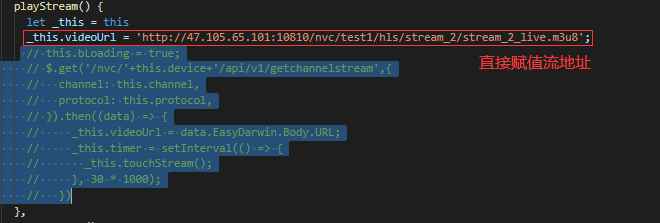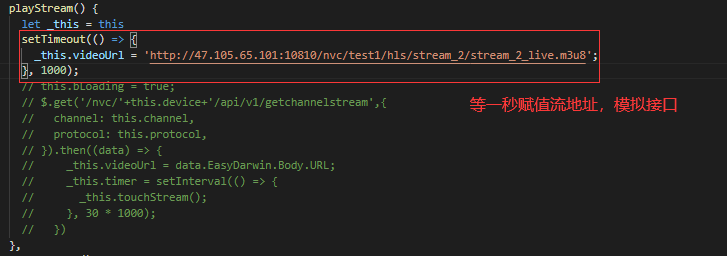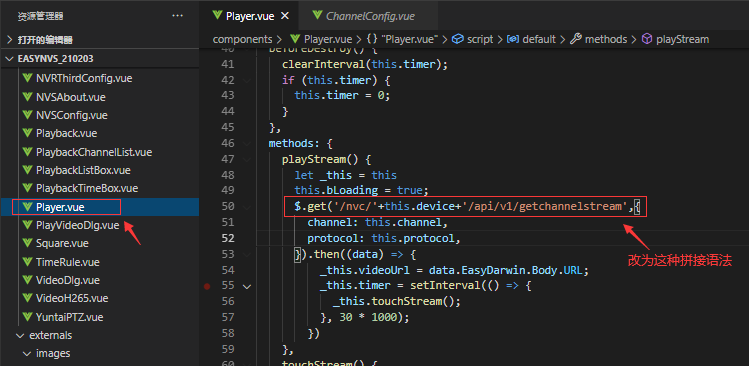视频安防智能监控系统管理平台EasyNVS手机端扫码直播展示无信号但是PC端可以播放是什么原因?
本文共 922 字,大约阅读时间需要 3 分钟。
为了更加便捷管理TSINGSEE青犀视频开发的视频智能安防监控系统,我们在前期就开发了支持EasyNVR平台的综合管理系统EasyNVS,当然综合管理的需求越来越旺盛,今年我们又拓宽了EasyNVS的接入。目前EasyDSS也可以通过接入EasyNVS的新版管理平台进行统一管控。

EasyNVS可以获取EasyNVR或者EasyDSS视频智能安防监控系统的全部能力,包括视频直播以及多终端支持的功能。根据部分用户的反馈,我们发现了EasyNVS平台通过手机端扫码观看直播时显示无信号,但是PC端观看时却可以播放的情况。

分析问题:
1.直接在代码中强制赋值直播流地址,就可以实现手机端的正常播放。

2.模拟接口异步赋值地址,在手机端就可以播放。

经过排查发现移动端不支持“…${…}… ”拼接字符串。

解决问题:
找到项目的Player.vue文件,修改代码中的字符串拼接语法。修改内容如下所示:

playStream() { let _this = this this.bLoading = true; $.get('/nvc/'+this.device+'/api/v1/getchannelstream',{ channel: this.channel, protocol: this.protocol, }).then((data) => { _this.videoUrl = data.EasyDarwin.Body.URL; _this.timer = setInterval(() => { _this.touchStream(); }, 30 * 1000); }) }, 修改完成后重新测试EasyNVS的播放功能,可见播放正常,预览如下:

EasyNVS云管理平台的web界面清晰呈现EasyNVR等设备接入状况、运行时长、宽带使用、存储空间和流量统计等状态,运维者直观获悉平台及设备健康状态,通过管理平台远程定位故障,帮助运维人员提高网络排查效率。
转载地址:http://ywfvz.baihongyu.com/
你可能感兴趣的文章
NIFI大数据进阶_FlowFile拓扑_对FlowFile内容和属性的修改删除添加_介绍和描述_以及实际操作---大数据之Nifi工作笔记0023
查看>>
NIFI大数据进阶_Json内容转换为Hive支持的文本格式_操作方法说明_01_EvaluteJsonPath处理器---大数据之Nifi工作笔记0031
查看>>
NIFI大数据进阶_Kafka使用相关说明_实际操作Kafka消费者处理器_来消费kafka数据---大数据之Nifi工作笔记0037
查看>>
NIFI大数据进阶_Kafka使用相关说明_实际操作Kafka生产者---大数据之Nifi工作笔记0036
查看>>
NIFI大数据进阶_NIFI的模板和组的使用-介绍和实际操作_创建组_嵌套组_模板创建下载_导入---大数据之Nifi工作笔记0022
查看>>
NIFI大数据进阶_NIFI监控功能实际操作_Summary查看系统和处理器运行情况_viewDataProvenance查看_---大数据之Nifi工作笔记0026
查看>>
NIFI大数据进阶_NIFI监控的强大功能介绍_处理器面板_进程组面板_summary监控_data_provenance事件源---大数据之Nifi工作笔记0025
查看>>
NIFI大数据进阶_NIFI集群知识点_认识NIFI集群以及集群的组成部分---大数据之Nifi工作笔记0014
查看>>
NIFI大数据进阶_NIFI集群知识点_集群的断开_重连_退役_卸载_总结---大数据之Nifi工作笔记0018
查看>>
NIFI大数据进阶_内嵌ZK模式集群1_搭建过程说明---大数据之Nifi工作笔记0015
查看>>
NIFI大数据进阶_外部ZK模式集群1_实际操作搭建NIFI外部ZK模式集群---大数据之Nifi工作笔记0017
查看>>
NIFI大数据进阶_实时同步MySql的数据到Hive中去_可增量同步_实时监控MySql数据库变化_操作方法说明_01---大数据之Nifi工作笔记0033
查看>>
NIFI大数据进阶_离线同步MySql数据到HDFS_01_实际操作---大数据之Nifi工作笔记0029
查看>>
NIFI大数据进阶_离线同步MySql数据到HDFS_02_实际操作_splitjson处理器_puthdfs处理器_querydatabasetable处理器---大数据之Nifi工作笔记0030
查看>>
NIFI大数据进阶_离线同步MySql数据到HDFS_说明操作步骤---大数据之Nifi工作笔记0028
查看>>
NIFI大数据进阶_连接与关系_设置数据流负载均衡_设置背压_设置展现弯曲_介绍以及实际操作---大数据之Nifi工作笔记0027
查看>>
NIFI数据库同步_多表_特定表同时同步_实际操作_MySqlToMysql_可推广到其他数据库_Postgresql_Hbase_SqlServer等----大数据之Nifi工作笔记0053
查看>>
NIFI汉化_替换logo_二次开发_Idea编译NIFI最新源码_详细过程记录_全解析_Maven编译NIFI避坑指南001---大数据之Nifi工作笔记0068
查看>>
NIFI汉化_替换logo_二次开发_Idea编译NIFI最新源码_详细过程记录_全解析_Maven编译NIFI避坑指南002---大数据之Nifi工作笔记0069
查看>>
NIFI集群_内存溢出_CPU占用100%修复_GC overhead limit exceeded_NIFI: out of memory error ---大数据之Nifi工作笔记0017
查看>>